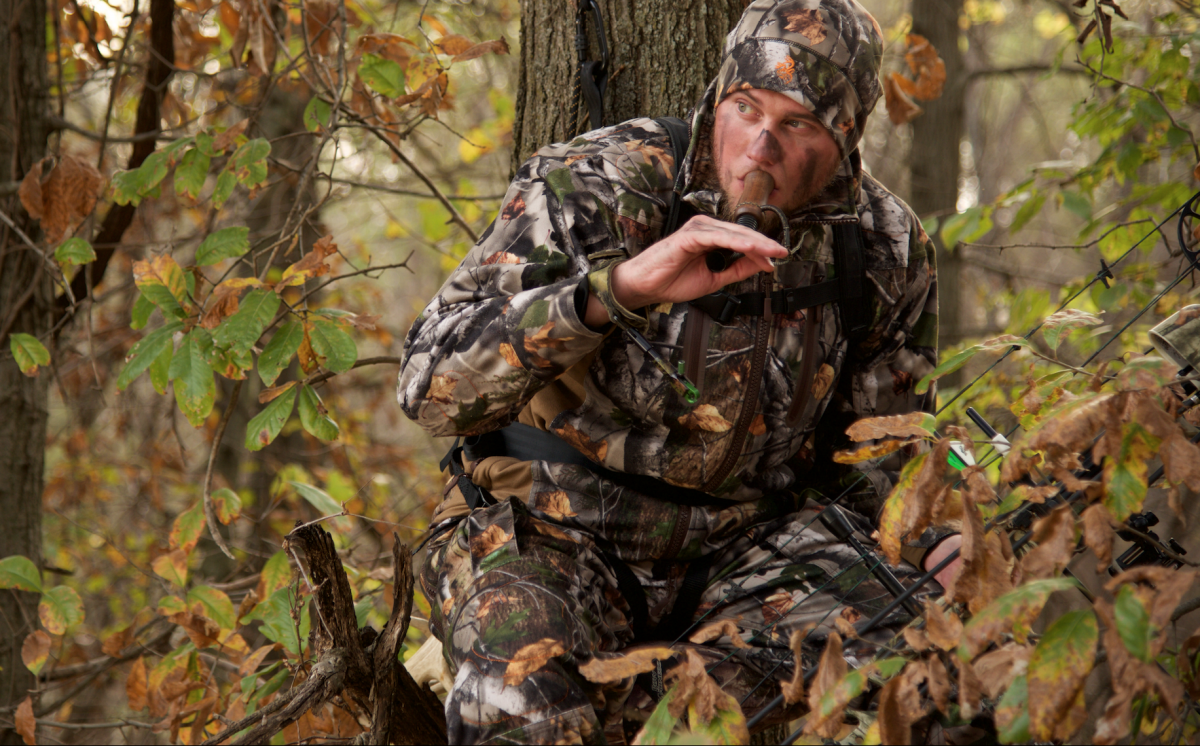A grunt tube – the cheapest, most impactful piece of hunting equipment a bow hunter can own, especially during or nearing the rut. The grunt tube has long been a staple piece of equipment a hunter throws around their neck before heading out to the woods, and rightfully so. It’s the one thing, other than a corn pile, that can bring that out-of-range buck into bow range with fairly decent success. Think about it . . . your bow or gun, treestand, binoculars, rangefinder, camouflage, etc. are all for nothing if you can’t get a buck within range. Sure, in the end they all played a part in the success, but not if it wasn’t for a couple of grunts from a $15 plastic tube. With that said, here’s a few things to keep in mind the next time you find yourself frantically reaching for your grunt tube as a buck cruises by.
The Herd Factor
The buck-to-doe ratio on any given hunting property is probably the biggest influencer on how effective calls are going to work whether it be rattling or grunting. If there’s little to no competition for does, bucks simply aren’t going to be interested in fending off another buck, which is exactly who you’re pretending to be when you grunt at him. Areas with high DOE:BUCK ratios (2:1 and higher) will make calling less effective overall. Unfortunately, this is what many public land hunters have to deal with.
Age class is also a big determinant of how effective your grunt call will be. A well balanced herd consists of a near equal buck to doe ratio, as well as, a good distribution of bucks amongst each age class. Having mature bucks (3+ year-old’s) creates competition and specifically an assertion of dominance, both of which will make bucks easier to call to. These are two reasons why you see calling work so well on TV shows.
 Check out HuntGuard® – our advanced line of all-weather hunting gear.
Check out HuntGuard® – our advanced line of all-weather hunting gear.
When and How to Grunt at a Buck
I’ll be the first to admit that I’m no expert on calling to whitetails, but I have had a fair amount of success with a grunt tube in the past, most recently during the 2015 season. You can watch the hunt here to see how I got a big buck to close the distance.
There’s two main things you should consider before you grab for your grunt tube. First, ask yourself if it is a buck you want to shoot? And second, are you in an enticing enough location to make the buck want to come check things out?
It may be tempting to play with a younger buck by grunting him in for a closer look, but in the end, all you’re doing is educating him. If he’s not a buck you’re interested in leave him be, it’ll only make him easier to fool in the coming years. If he is a shooter buck, then it’s go time! What do I mean by being in an enticing enough location? I mean you have to be positioned such that you will peak the curiosity of a buck to come in for a closer look. In the end, curiosity will kill the cat (or buck in this case). If a buck can’t see into where he thinks the call is coming from, he’s much more likely to come take a closer look compared to a call coming from an open field. It’s best to call in the direction of thick cover to portray a that a buck is hidden within. Consider using a decoy if you’re hunting an open area where a grunt might not be believable without a visual culprit.
It’s Now or Never
Okay, now let’s get into the real ‘meat & potatoes’ of calling – making actual noise with your call. You’ll hear a lot of the experts and more experienced big buck hunters say they only call to a buck if he’s looking a different direction. I agree. If he’s walking or looking somewhere other than you, hit him with a quick contact grunt, which is your standard short grunt. You’ll know if and when he hears you because he should stop and swing his head around. If he doesn’t give you the time of day, he probably didn’t hear you and you should hit him with another louder contact grunt or a short series of three grunts.
Once you’ve got his attention, it’s now time to study his behavior before making the next move. The fewer the grunts the better. I promise you grunting more and louder will not bring a buck in faster. By now your adrenaline is pumping, so it’s crucial to slow down and observe.
At this point the buck is likely to do one of two things:
- After a moments glance in your direction, he continues on without coming to check things out. If this happens, you don’t have much to lose. Hit him with another grunt or two and see what he does. If he keeps going, try the snort wheeze.
- Scenario two is what we hope happens and it can be quick or painstakingly slow. If it’s quick, you’ll know it and you probably won’t need to use your grunt tube anymore. Your short contact grunt intrigued him enough to immediately come and check you out. The slower reaction is somewhat typical of smart old bucks. After hearing your call, they turn and look for the source. Sometimes, they’ll sit and stare for 10+ minutes before deciding to come and investigate. If he’s on alert, it’s best to wait him out. Again, curiosity kills the cat. If, after the wait he goes back to doing what he was or looks away, it’s time to hit him with another grunt to let him know you’re still there.
Calling in Pressured Areas
It can be extremely tough to call in a buck on highly pressured hunting land – private or public. There’s usually a couple factors which limit the effectiveness of calling to pressured bucks. We touched on the first one already, that being an unbalanced herd. Highly pressured lands and an unbalanced herd often times go hand-in-hand. It’s not always the case, but more than likely you’re at a disadvantage right off the bat due to biological conditions.
The second factor making pressured bucks difficult to call in is hunter induced, and usually a result of a lot of blind calling. Blind calling is when you pick up your grunt tube or rattling antlers with the hope of “waking up the woods”, so they say. Meaning you’re not calling at a deer you can see or hear, but rather hoping to draw one in. It’s tough to resist the urge to blind call, especially if things are a bit slow and the rut is supposed to be cranking. Nonetheless, the more deer are exposed to these calls – knowingly or unknowingly – the more likely they are to ignore them. There’s not much you can do in these situations other than to keep your expectations in check. You can still grunt at a buck if he’s working out of range, but don’t keep blowing grunts at him if he seems to have ignored you.
There are a ton of factors determining if a buck will, in fact, come in to investigate the source of the foreign grunts. At the end of the day, calling success is going to vary on a per deer, per day, and per situation basis. It’s never a 100% guarantee that you’ll grunt in a buck. In fact, it’s more like a 50/50 shot on decent hunting land, and 25/75 split on pressured land.







